“Let food be thy medicine and medicine be thy food.” Hippocrates
“Eat less, move more, eat lots of fruits and vegetables, go easy on junk foods.” Marion Nestle, Ph.D., M.P.H., What to Eat
“Eat food, not too much, mostly plants.” Michael Pollan, Omnivore’s Dilemma
Nutrition Transition – Redefining Malnutrition
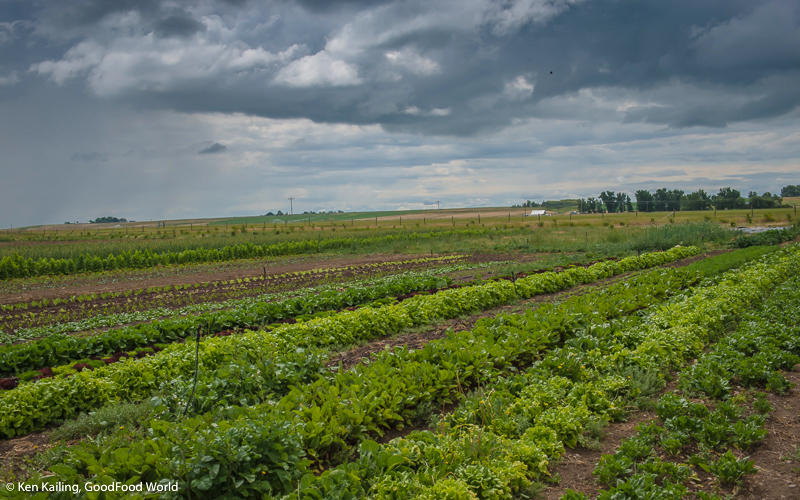
Farmers markets and CSAs sprout up every spring along with the lettuce and tomato plants. Supermarkets across the country, from small family-owned stores to big box chains, are all offering organic options throughout the store, not just produce any more. And we have more and more options to choose from in the “middle of the store.”
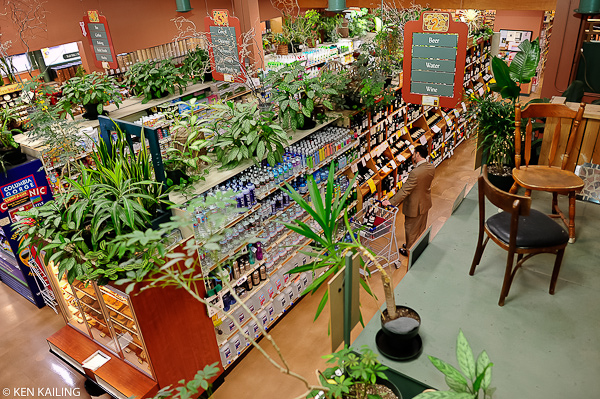 So, we all think – or would like to think – that we’re eating nutritious food. Do we even know what good “nutrition” is?
So, we all think – or would like to think – that we’re eating nutritious food. Do we even know what good “nutrition” is?
The word nutrition dates from the early 15th century and comes from the Latin nutrire meaning to feed or nourish. That was long before we focused on vitamins, protein, fat, salt, and other nutrient components more appropriately described as nutritionism: presenting dietary advice in the terms of individual nutrients, where some are viewed as good and some bad. It wasn’t until the mid-19th century that the term malnutrition came into use.
While malnutrition immediately generates images of children with spindly limbs and extended abdomens, we face a First World conundrum where malnutrition now includes not just insufficient food, but excessive or imbalanced consumption. In other words, one can consume either too little or too much and be malnourished.
Dietary imbalances or excesses are now associated with many of the leading causes of death and disability. “Over nutrition” results from eating too much, eating too many of the wrong things, not exercising enough, or taking too many vitamins or other dietary replacements.
The High Cost of Bad Food
The average American is faced with the components of a readily available “Western Diet” on all fronts and generally at a low cost. The Western Diet – also known as the American Standard Diet or the Meat-Sweet Diet – is loosely defined as one high in saturated fats, red meats, empty carbohydrates (junk food), and low in fresh fruits and vegetables, whole grains and pulses, seafood, and poultry.
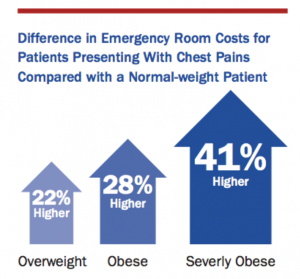
Consumption of the American Standard Diet has been linked to hypertension, heart disease, hypercholesterolemia, diabetes, obesity, and colorectal cancer. “In the United States and most Western countries, diet-related chronic diseases represent the single largest cause of morbidity and mortality. These diseases are epidemic in contemporary Westernized populations and typically afflict 50–65% of the adult population.”
Half to two-thirds of all American adults have one or more preventable chronic disease, many of which are related to poor quality eating patterns and physical inactivity. These chronic diet-related diseases continue to rise as do the related health risks and cost of health care.
In 2008, the medical costs linked to obesity were estimated to be $147 billion. By 2012, the total estimated cost of diagnosed diabetes – just one outcome of obesity – was $245 billion, including $176 billion in direct medical costs and $69 billion in decreased productivity.
What We Eat
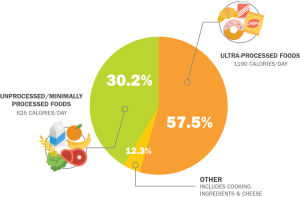
A recent French study analyzed the consumption of 3,300 food items by 104,980 adults with a median age of 42.8 years. In this large survey sample, “a 10% increase in the proportion of ultra-processed foods in the diet was associated with significant increases of 12% in the risk of overall cancer and 11% in the risk of breast cancer.” While this is preliminary research seeking to discover if there is an actual connection between processed foods and cancer, the results were stunning and more research is being planned.
With such a close correlation between ultra-processed foods – not bread and cheese which are indeed “processed” but “edible food-like substances” like Twinkies, most popular snacks, and children’s breakfast cereals – we would all be wise to consider eliminating, or at least vastly reducing, our consumption of empty calories.
We also know that multiple adverse health outcomes, including obesity, cardiovascular disease, type 2 diabetes, some cancers, are closely related to the low and extremely low consumption of fruits and vegetables. So exactly how much produce are we consuming? Only 10.7 percent of Montanans are meeting the daily intake requirements for fruit and 8.3 percent meet the daily requirements for vegetables.
According to the CDC, Montana’s Nutrition, Physical Activity, and Obesity Profile reads:
- 38.6% of adults reported consuming fruit less than one time daily.
- 20.5% of adults reported consuming vegetables less than one time daily.
- 57.8% of adults achieved the equivalent of at least 150 minutes (a total of 2 1/2 hours) of moderate intensity physical activity per week.
- 36.6% of adults were overweight.
- 26.4% of adults were obese.
We Grow What We Eat
Every five years, our government’s Dietary Guidelines Advisory Committee publishes a complex and detailed guide. The 2015-2020 version (the eighth edition) comprises 144 pages. In general, calorie consumption is recommended to be from 1,600 to 2,400 calories per day for adult women and 2,000 to 3,000 calories per day for adult men. The low range is for sedentary individuals, the high end for those who are active, and as adults age calorie requirements decrease.
Compare the recommended calorie intake to the actual amount of calories produced by our system of industrial agriculture and it’s clear that we are producing way more than we need. A report from the UN Food and Agriculture Organization (FAO) showed that in 2011 (the most recent date reported), in the US, 3,639 calories were produced for every man, woman, and child.
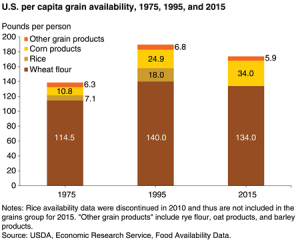 There is no question that there are more cheap junk foods on supermarket shelves than ever before and that obesity rates are at a record high. There is a strong correlation between farm subsidies and the overproduction of corn and soybeans – both of which are major ingredients in hyper processed foods full of empty calories. Between 1995 to 2010, 75 percent of farm subsidies went to support corn, wheat, soy, and cotton – and 46 percent of that for corn alone.
There is no question that there are more cheap junk foods on supermarket shelves than ever before and that obesity rates are at a record high. There is a strong correlation between farm subsidies and the overproduction of corn and soybeans – both of which are major ingredients in hyper processed foods full of empty calories. Between 1995 to 2010, 75 percent of farm subsidies went to support corn, wheat, soy, and cotton – and 46 percent of that for corn alone.
And, we have competing “boards” and associations exhorting us to eat more of the particular food product they are promoting: drink more milk, eat more meat, whole grain is good for you. And creating recipes like Pizza Hut’s Crazy Cheesy Crust Pizza with a ring of cheese pockets around the crust, two per the average slice. The pockets contain a five-cheese blend of provolone, asiago, mozzarella, fontina and mild white cheddar. It certainly is one way to get people to eat more cheese!
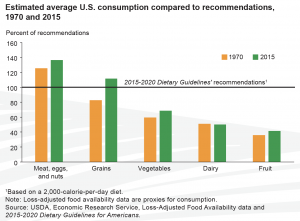 Comparing the consumption of five “food groups,” we see that Americans tend to fall far below the dietary guidelines for vegetables, dairy, and fruit. And we exceed the requirements considerably with our consumption of meat, eggs, and nuts, and grains.
Comparing the consumption of five “food groups,” we see that Americans tend to fall far below the dietary guidelines for vegetables, dairy, and fruit. And we exceed the requirements considerably with our consumption of meat, eggs, and nuts, and grains.
The category “Grain” includes cereal grains such as wheat, rice, and corn, less common grains like rye, oats, barley, sorghum, triticale, and millet, and pseudocereals like quinoa, teff, amaranth, and grasses other than rice.
One would assume in this land of plenty that all Montanans would have access to good food in the proper amounts for a well-balanced diet. However, it turns out that our state not only reflects the consumption patterns across the US, but we literally produce the food that Americans consume in excess: beef and grain.
Montana is an agricultural state where the land is mostly rural and used primarily for livestock and crop production. In 2015, The State of Montana generated billions of dollars from the following foods:
| Food Group | Farmgate Value | Notes |
| Meat animals | $1.7 billion | Exports accounted for 13.7 percent of beef production and 25.8 percent of pork production |
| Food grains | $1.1 billion | Approximately 80 percent of all Montana wheat and barley is exported |
| Vegetables and melons | $216 million | The majority is potatoes |
| Dairy products | $43.8 million | |
| Fruits and tree nuts | $1.7 million | Almost all of which is sweet cherries |
In Montana, where we used to grow nearly 90 percent of what we ate, today we import almost as much from surrounding states and other countries. We’d be hard-pressed to eat a healthy diet based on the crops and livestock we grow.
We face two challenges: to better match the food crops and livestock we grow to the dietary requirements of the population and to better match our actual food consumption to dietary recommendations for a healthier lifestyle. Because we live in mostly in an area where “dryland” farming and ranching is required, it could be difficult to change crops and production methods. However we can change what we eat, whether it is produced in Montana or nearby in the nation’s northwest region.
Changing What We Eat
“Eat less, move more, eat lots of fruits and vegetables, go easy on junk foods.” Marion Nestle, Ph.D., M.P.H., What to Eat
Changing the way you and your family eat
Eat less, skip the junk food, and focus on plants… learn to how shop, learn how to cook, and enjoy yourself. Were it so simple! How?
Shop the supermarket perimeters – that way you’ll get fresh food and you can skip the processed and packaged food located in the middle of the store. Around the outside aisles you’ll find produce, dairy, meat and fish, deli, and fresh baked goods – if you’re lucky enough to be in a store that has an in-house bakery. Sort of sounds like a simple description of “My Plate,” the government’s dietary recommendations!
Join a CSA, market garden buying club, or shop your farmers market for local meat, dairy, eggs, and produce in season. Not only will you get products that are fresher than they are in the store, you’ll support small local businesses. And chances are you’ll discover something new: unique vegetables, special cheeses, artisan-made fresh breads, and more.
Try your hand at minimal cooking. Steam, parboil, sear and braise; make sure your vegetables are “crisp tender” and they’ll have even more food value. Soak or sprout – lentils with their skins removed can be soaked in hot water for 20-30 minutes and tossed in a chopped salad. Whole grains, lentils, peas, and beans can be sprouted for additional nutrition.
Avoid CAFO (Confined Animal Feeding Operation) meat and eggs! Eat grassfed beef and lamb, pastured pork, eggs from pastured or free-range chickens. These animals are allowed “species-specific behavior,” meaning they can move freely about; graze, root, or scratch; and flap their wings, run, butt, and roll on the ground as they choose. And you get meat and eggs from healthier animals.
Changing the way your community supports good food and good health
Yes, it takes a village to raise a child, but it also takes a village to build and support a local food system. Gather a group, check this list, pick your project, and begin to build a food system that will support you and your community with good, fresh, local food.
- Create a local food availability information service; for example, an online producers’ directory including seasonal availability of products; online Forum for barter, gleaning or donations information.
- Build a local foods distribution system – or food hub – with online ordering and weekly or bi-monthly delivery to designated pick-up points.
- Create a food processing facility for value-added production either as part of a food hub or as a free-standing operation.
- Build/open a community storage facility: freezer, cooler, and dry storage. What ever happened to frozen food lockers?
- Organize a neighborhood composting project for kitchen and lawn waste.
- If your community has a community garden program, consider signing up for a plot. If not, build one.
- Help a school organize a student garden to grow food they can eat for school meals.
- Explore land mitigation ordinances linking acres preserved to acres developed to protect urban farm land.
- Organize a community land trust to protect farm land.
- Organize an indoor, year-round farmers’ market or public market.
- Organize and invest in a food co-op retail outlet, focusing on local foods.
Community programs you can organize and support.
- Support community education programs that teach people how to use whole foods, local foods, where to find them, process them for storage, eat seasonally, etc.
- Support parents, families and caregivers in efforts to offer healthier food and beverage choices, encourage ample physical activity and serve as good examples by spending less time on their screens and more time walking, biking and playing with their children.
- Ensure healthy food and drink options are available for kids in schools and child-care settings — and increase opportunities to be active and involved in high-quality physical activity programs;
- Make healthy food options more accessible — through efforts like healthy food financing strategies, nutrition assistance programs, nutrition education efforts and farmers’ markets;
- Provide healthcare coverage for obesity counseling and services — and strong preventive healthcare for children.
- Engage healthcare systems and hospitals to support access to services that promote their patients’ health beyond doctors’ appointments — such as through ongoing community-based programs, coaching and counseling efforts that can reduce healthcare costs and produce better results.
- Encourage smart community development and design — such as land use policies that support the development of green space, parks and trails, and Complete Streets initiatives, which hundreds of communities have adopted nationwide, that promote active living, including more walkable, mixed-use and recreation-friendly areas.
- Support the efforts of food and beverage companies to produce and market healthy, affordable options, and reduce calories, sugar, and fat in foods and drinks.
- Increase workplace wellness programs and employer-involvement in supporting community-wide health improvement initiatives,
These alternatives for change were developed by Sustainable Living Systems, located in the Bitterroot Valley, which stretches south from Missoula, Montana, to the Idaho border.
It’s Time for a Change
If we don’t understand the high cost of bad food – to ourselves, our families, our communities, and our economy – we will see life expectancy shorten, chronic diseases increase, and healthcare costs continue to spiral.
Understanding the relationship between government subsidies for the production of certain food products and the processing and marketing of those products makes clear the links and relationships in our food system that result in the production of and sale of “hyper-processed” foods.
And in the face of changing climate, more extreme storms and weather patterns, temperature extremes, and increased or decreased precipitation, we need to work to ensure our – and our communities’ – food security.
It’s time to look at what’s on your plate and decide if it’s time for a change. You can make that change happen.
More Reading
The State of Obesity: Better Policies for a Healthier America, https://stateofobesity.org/files/stateofobesity2017.pdf
Planet Fat, https://www.nytimes.com/series/obesity-epidemic
A Nasty, NAFTA-Related Surprise: Mexico’s Soaring Obesity, https://www.nytimes.com/2017/12/11/health/obesity-mexico-nafta.html
Lifestyle diseases are the biggest killers in India, http://www.downtoearth.org.in/news/lifestyle-diseases-are-the-biggest-killer-in-india-59235
Processed foods, calories and nutrients: Americans’ alarming diet, http://blog.aicr.org/2017/06/13/processed-foods-calories-and-nutrients-americans-alarming-diet/
Dietary Guidelines for Americans, 2015-2020 (“My Plate”), https://health.gov/dietaryguidelines/2015/
Montana 2016 Agriculture Statistics, https://www.nass.usda.gov/Statistics_by_State/Montana/Publications/Annual_Statistical_Bulletin/2016/Montana_Annual_Bulletin_2016.pdf
Ag and Food Statistics: Charting the Essentials, October 2017, https://www.ers.usda.gov/webdocs/publications/85463/ap-078.pdf
Hungry in Montana: Factors Contributing to Emergency Food Needs, 2016 Client Hunger Survey, http://mfbn.org/wp-content/uploads/2016/11/2016-Hungry-in-Montana-Report_email.pdf
Food banks feed people. Why don’t they fight hunger? https://newfoodeconomy.org/food-banks-hunger-board-members/
Access to Affordable and Nutritious Food: Measuring and Understanding Food Deserts and Their Consequences, https://www.ers.usda.gov/webdocs/publications/42711/12716_ap036_1_.pdf
Expanded Golden Triangle, Montana: Potential Community Foods Collaborative, https://mcdc.coop/wp-content/uploads/2017/11/MCDC-CRC-Final-Report.pdf
Too Big to Feed – Concentration of Power in Food and Ag, http://www.ipes-food.org/images/Reports/Concentration_FullReport.pdf
From the Ground Up Inspiring Community-based Food System Innovations, https://static1.squarespace.com/static/520ed291e4b066a62d157faa/t/5a3145ade4966b4de6df40b5/1513178558208/from+the+ground+up.pdf
Harvesting Opportunity, The Power of Regional Food Systems Investments to Transform Communities, https://www.stlouisfed.org/%7E/media/Files/PDFs/Community-Development/Harvesting-Opportunity/Harvesting_Opportunity.pdf
